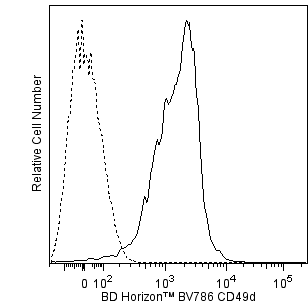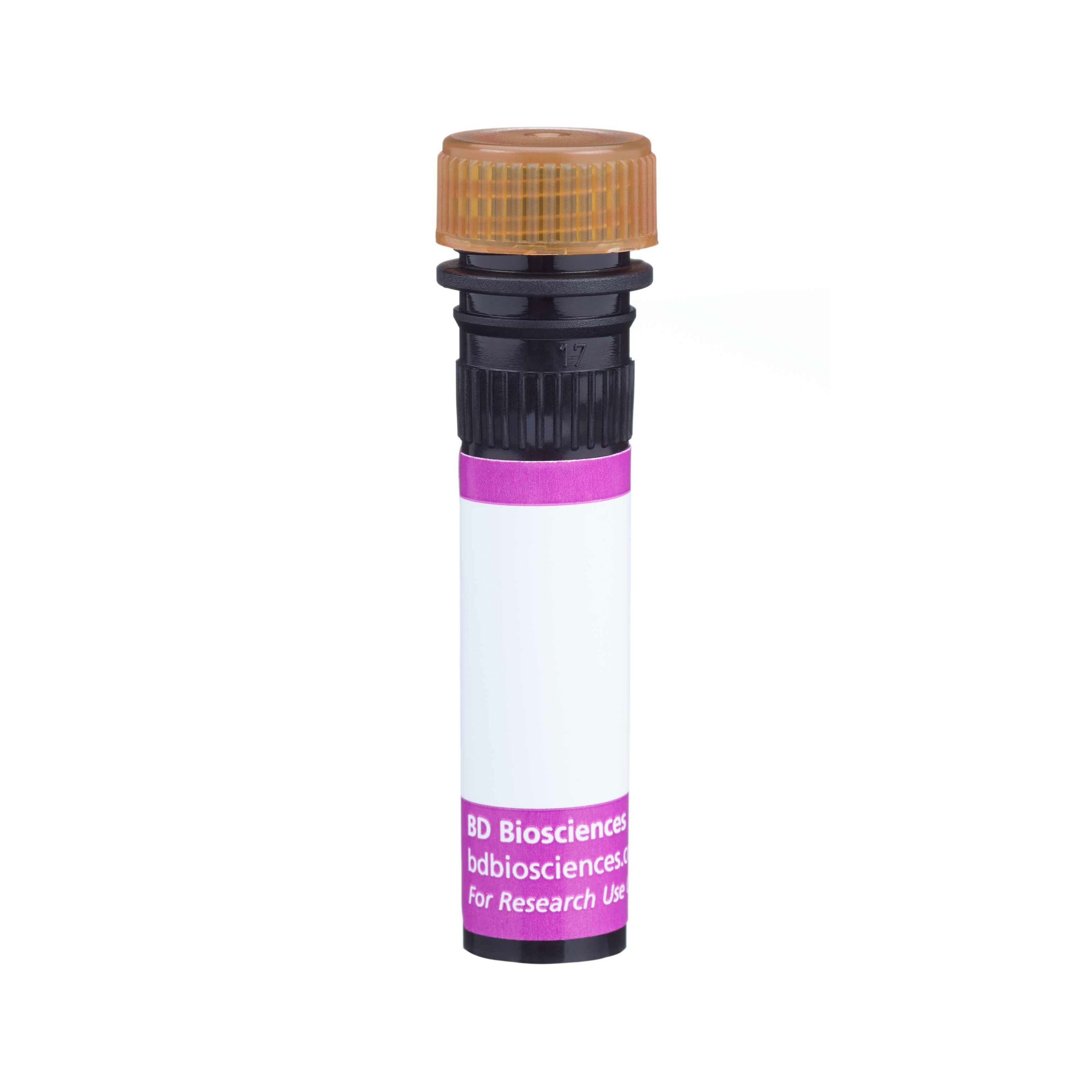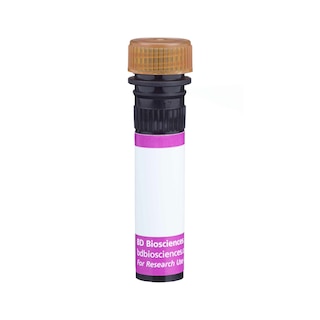Old Browser
Looks like you're visiting us from {countryName}.
Would you like to stay on the current country site or be switched to your country?




Flow cytometric analysis of CD49d expression on mouse splenocytes. Mouse splenic leucocytes were preincubated with Purified Rat Anti-Mouse CD16/CD32 antibody (Mouse BD Fc Block™) (Cat. No. 553141/553142). The cells were then stained with either BD Horizon™ BV786 Rat IgG2b, κ Isotype Control (Cat. No. 563334; dashed line histogram) or BD Horizon™ BV786 Rat Anti-Mouse CD49d antibody (Cat. No. 564397; solid line histogram). The fluorescence histogram showing CD49d expression (or Ig Isotype control staining) was derived from gated events with the forward and side light-scatter characteristics of viable leucocytes. Flow cytometric analysis was performed using a BD™ LSR II Flow Cytometer System.


BD Horizon™ BV786 Rat Anti-Mouse CD49d

Regulatory Status Legend
Any use of products other than the permitted use without the express written authorization of Becton, Dickinson and Company is strictly prohibited.
Preparation And Storage
Recommended Assay Procedures
For optimal and reproducible results, BD Horizon Brilliant™ Stain Buffer should be used anytime BD Horizon Brilliant™ dyes are used in a multicolor flow cytometry panel. Fluorescent dye interactions may cause staining artifacts which may affect data interpretation. The BD Horizon Brilliant Stain Buffer was designed to minimize these interactions. When BD Horizon Brilliant Stain Buffer is used in in the multicolor panel, it should also be used in the corresponding compensation controls for all dyes to achieve the most accurate compensation. For the most accurate compensation, compensation controls created with either cells or beads should be exposed to BD Horizon Brilliant Stain Buffer for the same length of time as the corresponding multicolor panel. More information can be found in the Technical Data Sheet of the BD Horizon Brilliant Stain Buffer (Cat. No. 563794/566349) or the BD Horizon Brilliant Stain Buffer Plus (Cat. No. 566385).
Product Notices
- Since applications vary, each investigator should titrate the reagent to obtain optimal results.
- An isotype control should be used at the same concentration as the antibody of interest.
- Source of all serum proteins is from USDA inspected abattoirs located in the United States.
- Caution: Sodium azide yields highly toxic hydrazoic acid under acidic conditions. Dilute azide compounds in running water before discarding to avoid accumulation of potentially explosive deposits in plumbing.
- For fluorochrome spectra and suitable instrument settings, please refer to our Multicolor Flow Cytometry web page at www.bdbiosciences.com/colors.
- BD Horizon Brilliant Violet 786 is covered by one or more of the following US patents: 8,110,673; 8,158,444; 8,227,187; 8,455,613; 8,575,303; 8,354,239.
- Cy is a trademark of GE Healthcare.
- BD Horizon Brilliant Stain Buffer is covered by one or more of the following US patents: 8,110,673; 8,158,444; 8,575,303; 8,354,239.
- Please refer to www.bdbiosciences.com/us/s/resources for technical protocols.
Companion Products






The R1-2 monoclonal antibody specifically binds to α4 chain (CD49d), which is expressed as a heterdimer with either of two β, β1 or β7 (also known as βp). The α4β1 integrin (VLA-4, CD49d/CD29) is expressed on most peripheral lymphocytes, thymocytes, and monocytes; while the α4β7 integrin (LPAM-1) is expressed on peripheral lymphocytes, but on only a small subset of thymocytes. These integrins mediate a variety of cell-cell and cell-matrix interactions, recognizing the ligands VCAM-1 (CD106) and fibronectin. There is evidence that levels of VLA-4 expression regulate the transendothelial migration of T lymphocytes into inflamed tissues. Integrin α4β7 also preferentially binds to the mucosal vascular addressin, MAdCAM-1. The R1-2 antibody blocks some α4 integrin-mediated binding functions. In combination with mAb 9C10 (MFR4.B) (Cat. No. 553313), binding of VLA-4 expressing cells to VCAM-1 can be almost completely inhibited.

Development References (8)
-
Andrew DP, Berlin C, Honda S, et al. Distinct but overlapping epitopes are involved in alpha 4 beta 7-mediated adhesion to vascular cell adhesion molecule-1, mucosal addressin-1, fibronectin, and lymphocyte aggregation. J Immunol. 1994; 153(9):3847-3861. (Biology). View Reference
-
Berlin C, Berg EL, Briskin MJ, et al. Alpha 4 beta 7 integrin mediates lymphocyte binding to the mucosal vascular addressin MAdCAM-1. Cell. 1993; 74(1):185-195. (Biology). View Reference
-
Ferguson TA, Kupper TS. Antigen-independent processes in antigen-specific immunity. A role for alpha 4 integrin. J Immunol. 1993; 150(4):1172-1182. (Biology). View Reference
-
Holzmann B, McIntyre BW, Weissman IL. Identification of a murine Peyer's patch--specific lymphocyte homing receptor as an integrin molecule with an alpha chain homologous to human VLA-4 alpha. Cell. 1989; 56(1):37-46. (Immunogen). View Reference
-
Holzmann B, Weissman IL. Peyer's patch-specific lymphocyte homing receptors consist of a VLA-4-like alpha chain associated with either of two integrin beta chains, one of which is novel. EMBO J. 1989; 8(6):1735-1741. (Clone-specific: Immunoprecipitation, Inhibition). View Reference
-
Kilshaw PJ, Murant SJ. Expression and regulation of beta 7(beta p) integrins on mouse lymphocytes: relevance to the mucosal immune system. Eur J Immunol. 1991; 21(10):2591-2597. (Biology). View Reference
-
Kinashi T, Springer TA. Adhesion molecules in hematopoietic cells. Blood Cells. 1994; 20(1):25-44. (Biology). View Reference
-
Romanic AM, Graesser D, Baron JL, Visintin I, Janeway CA Jr, Madri JA. T cell adhesion to endothelial cells and extracellular matrix is modulated upon transendothelial cell migration. Lab Invest. 1997; 76(1):11-23. (Biology). View Reference
Please refer to Support Documents for Quality Certificates
Global - Refer to manufacturer's instructions for use and related User Manuals and Technical data sheets before using this products as described
Comparisons, where applicable, are made against older BD Technology, manual methods or are general performance claims. Comparisons are not made against non-BD technologies, unless otherwise noted.
For Research Use Only. Not for use in diagnostic or therapeutic procedures.
Report a Site Issue
This form is intended to help us improve our website experience. For other support, please visit our Contact Us page.